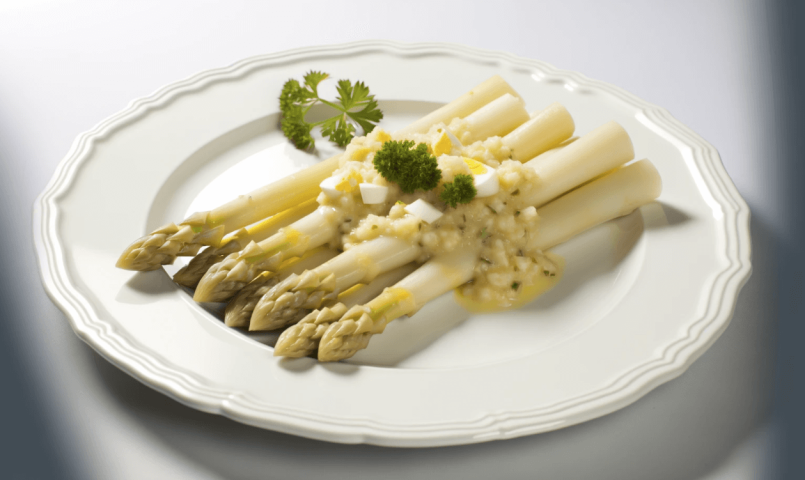
Asparagus, often described as the "white gold," is not just a fundamental part of Flemish culinary tradition but also has a rich and complex history that dates back thousands of years. This blog post highlights the fascinating journey of asparagus from antiquity to modernity, its cultural significance, and the finer details of its cultivation.
Extensive History of Asparagus
The cultivation of asparagus began in ancient Greece, where this vegetable was prized for its unique flavor and supposed medicinal properties. The Greeks also used asparagus in rituals and considered it an aphrodisiac. This belief was passed on to the Romans, who spread asparagus throughout Europe as part of their expanding empire.
In the Middle Ages, the popularity of asparagus declined, but it was revived during the Renaissance when it was once again cherished by European nobility. King Louis XIV of France was so fascinated by asparagus that he had special greenhouses built to cultivate it year-round.
Botanical Background
Asparagus belongs to the liliaceae family, which also includes lilies and tulips. It is a perennial plant, meaning the plant can survive multiple years and regrow each spring from its root system. The scientific name for asparagus is Asparagus officinalis.
Cultivation and Harvest
The cultivation of asparagus is unique because it is one of the few vegetable varieties that need several years to establish from seed before they can be harvested commercially. An asparagus plant can be productive for up to 20 years, representing a long-term investment for farmers. The plants thrive best in sunny locations with well-drained soil and must be well-managed to ensure the quality of the harvest.
Harvesting asparagus is labor-intensive, as each spear must be cut by hand. This usually occurs in the early morning hours when the spears are still cool.
Culinary Applications
Asparagus is used worldwide in various dishes, from simple steamed preparations to complex sauces and soups. It can be cooked, grilled, blanched, or eaten raw. Asparagus is particularly popular in French, Italian, and of course, Belgian cuisine. In Flanders, it is traditionally served with melted butter, a pinch of nutmeg, chopped parsley, and hard-boiled eggs.
Nutritional Benefits
Asparagus is an excellent source of vitamin K, essential for blood clotting, and also offers significant amounts of vitamin C, folate, iron, and fiber. It is low in calories and sodium, making it a healthy addition to any diet.
Fun Facts and Tips
- Asparagus urine: Not everyone can perceive the characteristic odor that appears in the urine after eating asparagus, due to individual differences in the metabolism of sulfur compounds.
- Color variations: The color of asparagus is influenced by the amount of sunlight during growth. White asparagus is grown underground to prevent exposure to light, resulting in their pale color. Purple asparagus is richer in sugars and contains fewer fibers, making it sweeter than the green and white varieties.
Conclusion
Cooking asparagus in the Flemish style is a wonderful way to celebrate spring and experience the rich culinary traditions of Flanders. This versatile vegetable, offering both a deep history and a variety of health benefits, remains a favorite in many cuisines around the world. Whether preparing a simple dish with steamed asparagus or a more refined recipe, asparagus inspires the creativity of cooks worldwide.
Flemish Style Asparagus

| Category: | Main Dishes |
| Cooking Time: | 1 h |
| Portions: |
4
|
| Kitchen: | Belgian Cuisine |
| Cost Range: | Moderate |
Ingredients:
-
24 pieces White asparagus
-
4 Eggs
-
1 bunch Parsley
-
200 gr Farmhouse butter
-
1 pinch Nutmeg
-
1 pinch Pepper
-
1 pinch Salt
Instructions:
- Peel the asparagus from the tip downwards and remove the woody end. Cook them until al dente in lightly salted water. Depending on the thickness, this should take about 5 to 12 minutes.
- Boil the eggs for about 8 to 9 minutes for a hard-boiled consistency. Immediately cool them under cold water to stop the cooking process. Peel the eggs and mash them with a fork.
- Finely chop the washed parsley. Add it to the mashed eggs and season with nutmeg, pepper, and salt.
- Melt the butter in a pan and skim off the foam that forms on top. Add the clarified butter to the egg mixture and mix thoroughly.
- Serve the asparagus on a plate and lay the egg mixture with butter and parsley in a wide strip over them, leaving the tips of the asparagus uncovered.
Tip: For an extra flavor dimension, you can add some finely grated lemon zest to the egg mixture before stirring in the clarified butter. This adds a fresh touch to the dish, complementing the soft flavor of the asparagus.
